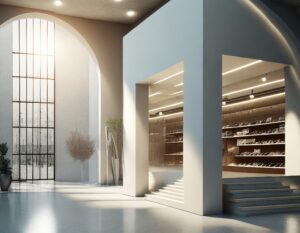Charleston’s port access, coastal location, and relative affordability have continued to draw both retailers and new residents as we progress through the first half of 2023. This South Carolina city has maintained its allure, bolstered by robust regional and national tourism. Significantly, Charleston’s population growth has consistently surpassed the national average, a trend that underscores the city’s increasing appeal as a destination for both living and business.
Page Contents
Impact of E-commerce on Retail Leasing Trends
Despite the ongoing allure of Charleston, retail leasing has experienced a noticeable shift. This change, however, is less about a decline in interest and more about an adaptation to  the evolving retail landscape. The rise of e-commerce has led retailers to reconsider their space requirements, resulting in smaller average lease footprints. In 2022, the average lease size dipped to 2,720 square feet, a notable decrease from the 3,500 square feet average observed between 2010 and 2019. This trend reflects a strategic shift in retail operations, influenced heavily by the growing dominance of online shopping.
the evolving retail landscape. The rise of e-commerce has led retailers to reconsider their space requirements, resulting in smaller average lease footprints. In 2022, the average lease size dipped to 2,720 square feet, a notable decrease from the 3,500 square feet average observed between 2010 and 2019. This trend reflects a strategic shift in retail operations, influenced heavily by the growing dominance of online shopping.
Vacancy Rates and Construction Trends
Interestingly, this cautious approach to retail space has positively impacted vacancy rates in Charleston. Despite a trend of flat to negative absorption rates in the first half of 2023, the city’s vacancy rates have remained below the national average, currently standing at 3.7%. This is partly due to a more restrained approach to new retail construction, a strategic decision that has helped maintain a healthy balance in the local real estate market.
Expansion of Charleston’s Retail Tenant Portfolio
Charleston’s retail tenant portfolio is poised for expansion as we look ahead. Major grocers, including Aldi, Publix, and Harris Teeter, are planning to open new locations in key areas such as North Charleston, Summerville, and West Ashley. Additionally, Lidl plans to make a significant entry by opening a 30,000-square-foot space in Dorchester County, slated for late 2023. Walmart’s aggressive expansion, including the opening of seven stores since 2010 and a new three million-square-foot imports center in 2022, further underscores the market’s vibrancy.
Revitalization of Suburban Big-Box Spaces
An exciting development in Charleston’s retail landscape is the repurposing of older big-box spaces in suburban areas. These large, previously unoccupied spaces are finding new life with innovative uses. For instance, Urban Air Indoor Adventure Park and Stroud Discount Window and Door have moved into substantial spaces in North Charleston, signaling a trend of creative reuse. This shift not only revitalizes these areas but also contributes to the diversity of the retail environment. Notably, general, freestanding retail and suburban power center properties are currently experiencing the lowest vacancy rates, at 2.3% and 0.6%, respectively.
Charleston’s Rising Retail Rental Rates
Charleston’s retail market is currently experiencing a significant uptick in rental rates, positioning it as the most expensive in the state. The city’s average asking rent now stands at approximately $24.00 per square foot, according to CoStar, reflecting an increase due to factors such as ongoing coastal tourism appeal, high land costs in the historically preserved downtown peninsula, and steady population growth. These elements have collectively contributed to stabilizing and driving rent growth in the area. Notably, the overall rent increase in Charleston has been recorded at 4.4% year over year, surpassing the national average. Within this spectrum, power centers and neighborhood center properties are leading the pack, showcasing annual rent growths of 6.0% and 5.2%, respectively.
Submarket Variations in Rental Rates
The rental landscape in Charleston is not uniform across its various submarkets. Downtown Charleston, for instance, commands a premium, with average rents nearly doubling the market-wide rate, exceeding $43 per square foot. High rental rates in the downtown area significantly hinder entry. However, consistent foot traffic from College of Charleston students, numerous tourist attractions, and hotels bolster the area’s appeal. This vibrant environment fuels considerable consumer spending.
Additionally, areas like North Charleston and Mount Pleasant are witnessing rent growth that exceeds the market-wide average. The retail demand in these areas is closely following residential development trends. North Charleston, along with Summerville and Goose Creek, is attracting retail interest due to a surge in industrial employment and the emergence of new residential projects. In Mount Pleasant, the growth in single-family homes has been a catalyst for bringing high-end retail closer to consumers.
Revival of Construction Activity in Charleston’s Retail Market
The first half of 2023 has marked a significant uptick in construction activity in Charleston’s retail sector, following a period of moderate activity from 2018 to 2022. This resurgence in development comes after a phase where a limited construction pipeline played a key role in maintaining positive rent growth and keeping the metro-wide vacancy rate below the national average. Currently, builders are actively constructing approximately 660,000 square feet of retail space across the metro area, with plans to complete nearly half of it by the beginning of the following year. While the market has demonstrated robust demand over the past few years, this influx of new retail space signifies some upward pressure on the market-wide vacancy rate in the short term.
Trends in New Retail Developments
New retail development in Charleston predominantly focuses on smaller-scale projects or as components of larger mixed-use developments. Significant contributions to the retail construction pipeline include the ongoing development at the Nexton mixed-use project in Summerville and the Navy Yard redevelopment in North Charleston. These projects account for a substantial portion of the retail space currently under construction in the market. In Downtown Charleston, new multifamily projects are increasingly incorporating substantial first-floor retail spaces. A notable example is the transformation of the former Sergeant Jasper Apartments in Harleston Village by The Beach Company, which now includes 25,000 square feet of new retail space alongside 75,000 square feet of office space and approximately 216 luxury apartments.
Diversity in Retail Construction Projects
A variety of other significant projects also characterize the Charleston retail construction landscape. These include auto sales centers like the Mercedes-Benz Van Center in Berkeley County and several strip centers in rapidly growing suburbs such as Mount Pleasant and Summerville. The largest ongoing project is Cedar Grove in North Charleston, an 80,500-square-foot power center, which has already secured preleases from major retailers like HomeGoods, Ross, PetSmart, ULTA, Aldi, and Fivebelow. Additionally, TopGolf has recently completed a new 70,400-square-foot center in North Charleston. Aligning with the trend of following population growth to the suburbs, grocery-anchored centers are also on the rise, with the 56,000-square-foot Nexton Harris Teeter and the 51,450-square-foot Publix in Dorchester County being prime examples. Notably, the market has already preleased about 70% of all retail construction in the area, indicating strong demand.
completed a new 70,400-square-foot center in North Charleston. Aligning with the trend of following population growth to the suburbs, grocery-anchored centers are also on the rise, with the 56,000-square-foot Nexton Harris Teeter and the 51,450-square-foot Publix in Dorchester County being prime examples. Notably, the market has already preleased about 70% of all retail construction in the area, indicating strong demand.
Retail Transaction Trends in Charleston’s Market
Over the past 12 months, Charleston’s retail market has seen approximately $309 million in transaction volumes, marking a significant cooling in the first half of 2023. This downturn represents a shift from the momentum seen in 2022, which was the second consecutive year with more than $400 million in total retail transaction volume. The recent decrease in sales activity is likely a reaction to the growing economic uncertainty and the impact of rising interest rates.
Characteristics of Recent Retail Sales
Over the past year, the retail sales that have occurred predominantly involved freestanding retail or neighborhood center properties. Notably, out-of-state buyers drove a substantial portion of the total sales volume. Despite the recent slowdown in transaction volumes, Charleston continues to be one of the fastest-growing areas in South Carolina, both in terms of population and job growth. In the past year, some of the largest deals have concentrated in the metro’s most rapidly expanding areas. In the most significant transaction of the last year, developer Edens acquired a 25-property portfolio of freestanding retail properties on Kiawah Island from Northwood Investors. This portfolio, encompassing 181,140 square feet, was sold for $125 million, translating to an impressive $689 per square foot.
Downtown Charleston’s Redevelopment Sales
In Downtown Charleston, redevelopment sales have gained popularity. One notable deal in October 2022 involved Chicago-based MCZ Development purchasing a 14,100-square-foot bowling alley on 131 Columbus Street for $10 million. This property, which includes a parcel of just under half an acre, is earmarked for redevelopment into a hotel. Additionally, in January 2023, an undisclosed investor acquired two buildings on upper King Street for $12 million, or $884 per square foot. In April 2023, Middle King Partners purchased five buildings totaling 65,528 square feet further south on King Street for $15 million, or $229 per square foot.
Suburban Retail Investment Highlights
The retail market has also seen significant activity in Summerville, a rapidly growing suburb. The California-based REIT Realty Income Corporation purchased an 88,000-square-foot space currently occupied by BJ’s Wholesale Center for $20.35 million, or $232 per square foot, from Paum Sales Corporation. This sale represented a notable return on Paum’s 2018 investment when they acquired the property for $16.7 million, or $190 per square foot.
Exploring Opportunities in Charleston’s Retail Market
Charleston’s retail sector offers diverse investment opportunities. Current trends show a market responsive to economic changes. Understanding these market dynamics is crucial for strategic investments with the potential for high returns. To delve deeper into Charleston’s retail landscape, contact Lumicre for further discussion.